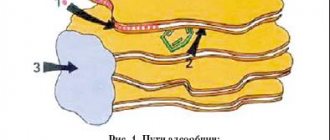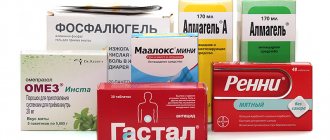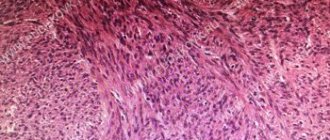The text is presented for informational purposes only. We strongly urge you not to self-medicate. When the first symptoms appear, consult a doctor. We recommend reading: “Why you can’t self-medicate?”
Intestinal antiseptics are a group of drugs that are effective against most pathogens of infectious diarrhea. The distinctive features of this pharmacological group are moderate systemic effects and a predominant antimicrobial effect in the cavity of the digestive canal.
Description of the disease
Intestinal infection refers to diseases of the gastrointestinal tract caused by bacterial, viral or fungal agents.
The most common pathogens are: enteroviruses, rotaviruses, salmonella, staphylococcus, dysentery bacillus, etc. Intestinal tract infections are widespread in childhood. In terms of incidence, they are second only to respiratory diseases. Infection, as a rule, occurs due to non-compliance by the child and his parents with the rules of personal hygiene, sharing toys and other household items with infected people, and eating unwashed vegetables and fruits. The disease can be identified by impaired bowel movements, nausea, vomiting, a sharp decrease in appetite and an increase in body temperature.
If you suspect that a child has an intestinal infection, you should immediately seek advice from a gastroenterologist. Lack of treatment can provoke the development of serious complications: septic condition, shock due to vascular paralysis due to bacterial intoxication, acute kidney failure, heart failure, etc.
Symptoms of intestinal infection
The symptoms of infectious pathology depend on the type of pathogen that has entered the child’s body and the presence of associated disorders. The most characteristic manifestations are:
- feverish condition;
- headache;
- muscle aches, weakness;
- pain in the abdominal area;
- refusal to eat food;
- nausea;
- vomit;
- diarrhea (possible presence of stool mixed with mucus).
If the child is not provided with timely assistance, the disease takes a severe course. Therefore, the main manifestations of the disease may include:
- a sharp deficiency of fluid in the body (dry skin and mucous membranes, weight loss, practically no urine);
- decreased pressure in the arteries;
- confusion;
- convulsions.
In order to prevent the development of complications, the child must be brought for examination to a specialist even when the first symptoms of an intestinal infection appear - refusal to eat, drowsiness, nausea and vomiting.
List of drugs
The most commonly prescribed drugs are:
- phthalazole;
- furazolidone;
- nifuroxazide (enterofuril, ersefuril);
- phthazine;
- sulgin.
Each of the drugs is characterized by advantages and disadvantages. Only a doctor (infectious disease specialist or family doctor) can assess the intended benefits and possible harm.
Phthalazole
It disrupts the metabolism of folic acid in the microbial cell, which makes further formation of new microbial particles impossible.
In this way, its antimicrobial activity is realized against many bacteria and some large viruses. High concentration inside the intestinal lumen allows you to quickly achieve the desired effect. To maintain it, you need to take the drug 4 times a day at regular intervals. Be sure to read:
How is rotavirus intestinal infection manifested and treated?
Phthalazole also has anti-inflammatory activity, as it inhibits the migration of leukocytes to the site of inflammation. The combined action ensures rapid recovery of the patient.
Phthalazole is available in the form of medium-sized white tablets. This dosage form is affordable for patients of any income level. The average price for 10 tablets does not exceed 15-25 rubles.
Phtazin
In many ways similar to phthalazole. Has a longer duration of action. When used systematically, it is found in sufficient concentrations in the blood, which can be important in the treatment of severe bacterial intestinal infections.
Furazolidone
It disrupts tissue respiration processes, which destroys the microbial cell.
It is an MAO inhibitor, so it is important to correctly assess the possibility of potential drug interactions. Furazolidone is active not only against gram-positive and gram-negative bacteria, but also against protozoal pathogens (giardia, trichomonas). To create a stable concentration in the blood, it is necessary to take furazolidone quite often - 4 times a day, the dosage is selected in accordance with the age and weight of the patient.
Available in the form of small yellow tablets. The small size of the tablets makes it possible to use furazolidone in pediatric practice. The cost of a course of treatment with furazolidone is 150-200 rubles.
Nifuroxazide
The most modern active ingredient in the group of so-called intestinal antiseptics. It has a multicomponent effect: it disrupts tissue respiration and metabolic processes inside the microbial cell, reduces the production of endotoxins produced by pathogens of intestinal infections, restores normal biocenosis inside the intestine, stimulates local immunity, and when infected with intestinal viruses, prevents the possible development of association with pathogenic bacteria.
Available in the form of tablets, capsules or syrup. Such a variety of dosage forms allows you to choose the most convenient form of therapy for the patient. Unlike other intestinal antiseptics, it can be used not 4, but only 3 times a day.
Causes of intestinal infection
Infection with intestinal infections occurs through the fecal-oral and household contact routes. Bacteria, viruses and fungi are transmitted from a sick person to a healthy person through shared objects (toys, dishes, towels, etc.). Children are the most susceptible to the disease. This is due to the following reasons:
- Children have lower acidity of gastric juice compared to adults.
- An incompletely formed immune system cannot resist pathogenic microflora.
- Children are more likely than adults to not observe the rules of personal hygiene.
- Children attending kindergartens and schools have closer contact with peers, which facilitates the process of transmission of infection.
Intestinal infection is often called the disease of dirty hands. Young children often ignore basic hygiene standards - they forget to wash their hands after using the toilet and before eating, they often pick up unwashed objects previously handled by infected peers, they play with pets, which can also be carriers of various infections, etc.
Antibacterial drugs in the treatment of acute intestinal (diarrheal) diseases
Despite progress in the treatment and prevention of infectious diseases, acute intestinal (diarrheal) diseases (AID) continue to be a very significant problem in all countries of the world without exception, since they still consistently hold second place in the structure of morbidity and mortality in the world [1, 2 ]. According to the World Health Organization, more than 2 million people die from diarrheal diseases every year worldwide [3]. In economically developed countries, such as the United States, the annual incidence of acute diarrhea is estimated from 211 million to 375 million cases per year (incidence rate - 1.4 cases per person), which causes more than 900 thousand hospitalizations and about 6 thousand deaths [4, 5]. The problem of OKDZ remains no less pressing for the Russian Federation.
As numerous studies show [6–8], the etiological structure of ACDD has undergone certain changes in recent decades and can vary significantly in different geographical areas. Thus, in particular, in a number of economically developed countries, Shigella spp. began to be isolated less frequently during the examination of patients with diarrhea of an infectious nature. and Salmonella spp., while the proportion of some other pathogens (for example, enterovirulent (diarrheagenic) Escherichia coli) increased. A characteristic feature of the countries of the Western Hemisphere is a significant increase in acute diarrhea of viral etiology. Such a diverse etiological structure of ACDD requires the doctor to have a differentiated approach to the treatment, and above all to the prescription of antimicrobial drugs (AMP).
In this regard, the adequacy and effectiveness of therapy in patients with ACDD depends on the timely determination of the etiology of the disease, which is possible only through the use of special laboratory research methods. Thus, in particular, modern methods of laboratory diagnostics for OKDZ make it possible to increase the rate of etiological decoding to 35–40%, whereas in the 70s of the twentieth century it did not exceed 10–15%.
AMPs occupy an important place in the treatment tactics of patients with ACDD, since their timely administration (of course, if there are indications for use) can really help to shorten the duration of the disease, reduce its severity, mortality and eliminate the adverse consequences of the disease [9]. However, this does not serve as evidence of the absolute necessity of using AMPs in patients with ACDD. Moreover, the irrational use of AMPs not only contributes to the formation of multiresistance, but in some cases can also negatively affect the course of the disease itself. The adverse consequences of irrational use of AMPs include the possibility of developing dysbiosis with increased colonization of the intestinal mucosa by opportunistic bacteria and fungi, the formation of long-term carriage of Salmonella spp. and Clostridium (C.) difficile, an increased risk of complications associated with increased production of Shiga-like toxin by Escherichia (E.) coli [10]. The development of diarrheal syndrome in bacterial OACD is due to the presence of certain pathogenicity factors in the pathogens, among which the key place is occupied by the production of toxins (enterotoxins, cytotoxins) and invasiveness. The nature of the emerging pathological process depends precisely on the expression of pathogenicity factors by the pathogen.
Enterotoxins are protein molecules that, through the activation of natural intracellular mechanisms (cyclic adenosine monophosphate, guanosine monophosphate, etc.), are capable of increasing the secretion of fluid and electrolytes into the intestinal lumen, resulting in dehydration of the body. Most bacterial pathogens of ADHD are capable of producing various types of enterotoxins (Vibrio (V.) cholerae, E. coli, Salmonella spp., Campylobacter jejuni, Yersinia enterocolitica, C. difficile, C. perfringens, Staphylococcus (S.) aureus, Bacillus (B. ) cereus, etc.). The peculiarity of the action of this class of toxins is that they do not cause morphological changes in the intestinal mucosa.
Cytotoxins are also protein molecules, but their mechanism of action is reduced to damage and death of various types of cells (primarily epithelial cells), the development of inflammation and increased membrane permeability. Cytotoxin-producing bacteria that cause OCDS include Shigella dysenteriae, Salmonella spp., Yersinia enterocolitica, Campylobacter jejuni, E. coli (primarily E. coli O157:H7), C. difficile, C. perfringens, etc.
Invasiveness refers to the ability of bacteria to penetrate membranes, penetrate the cytoplasm of epithelial cells and, multiplying in it, destroy the invaded cells. In some cases, invasion is manifested by translocation of the pathogen into the submucosal layer. Bacterial strains that are invasive cause the development of a pronounced inflammatory reaction in the submucosal layer of the intestine with the possible formation of ulcers and erosions on the mucous membrane. Shigella spp., Salmonella spp., Campylobacter jejuni, Yersinia enterocolitica, some species of E. coli, etc. are invasive.
Ultimately, the nature of the emerging pathological process and the clinical manifestations of the disease will directly depend on the pathogenicity factors that the pathogen expresses. According to the variants of the clinical course, OKDZ can be classified depending on the level of involvement in the pathological process of various parts of the gastrointestinal tract (gastritis, gastroenteritis, enterocolitic, gastroenterocolitic) and systemic manifestations of the disease. Table 1 shows the main clinical and epidemiological data characterizing various OKDZ of bacterial etiology.
Determining the duration of the incubation period is of great importance in establishing the primary diagnosis. The shortest incubation period in the group of OKDZ of bacterial etiology is typical for foodborne toxic infections (PTI), which is explained by the entry into the human body with transmission factors (food products) of not only the pathogen itself, but also already produced enterotoxins. Thus, with PTI of staphylococcal etiology, the incubation period can be less than 6 hours, and with other etiologies - from 6 to 24 hours. A more prolonged incubation period (from 16 to 72 hours) is typical for salmonellosis, shigellosis, campylobacteriosis, yersiniosis, escherichiosis, vibrio. infections, including cholera.
OKDZ, caused by pathogens capable of producing only enterotoxins, are responsible for the development of diseases that occur in the gastroenteritis and gastritic variants (as a rule, this is typical for IPT). In typical cases, the use of AMPs in these patients is not advisable, since the microbial factor plays a limited role in the pathogenesis of the disease. Only in isolated cases associated with a violation of the body’s protective properties, hematogenous dissemination of the pathogen is possible in patients with IPT [11].
AMP therapy is primarily needed by patients who show signs of exudative (inflammatory) diarrhea caused by invasive strains of bacteria; persons with severe disease (including severe dehydration); children under 3 years of age and elderly people; patients with direct and indirect signs of immunosuppression (including persons who have undergone organ and tissue transplantation, patients with diabetes mellitus, liver cirrhosis, chronic renal failure, etc.); persons with signs of generalization of the process.
It is important to remember that the choice of AMPs in the treatment of patients with ACDD should not be based on traditional ideas about the effectiveness of any group of drugs, but on the results of monitoring the sensitivity of enteropathogenic bacteria to AMPs isolated in a specific geographic area. If information on regional resistance is missing or unavailable, information obtained in neighboring regions or the results of microbiological analysis of local outbreaks and epidemics in recent years should be taken into account. The effectiveness of prescribed AMPs is assessed by the main clinical manifestations within 48 hours from the start of therapy. The criteria for effectiveness in ACDD most often include such clinical signs as a decrease in the frequency of bowel movements, a decrease in the amount of pathological impurities in the stool (blood, mucus, pus), a decrease in the severity of fever, an improvement in appetite, etc. The highest clinical effectiveness of AMPs is observed at the earliest possible at the beginning of its use, which, in addition, reduces the risk of contact spread of the pathogen. Table 2 shows the main groups of AMPs and patterns of their use in adults with ACDD of bacterial etiology.
A clear illustration is provided by AMPs, which were recently widely used in the treatment of shigellosis, but are not recommended for use at the present stage. These include:
- ampicillin, chloramphenicol (chloramphenicol), trimethoprim/sulfamethoxazole (co-trimoxazole), tetracycline. These drugs have been widely used in the treatment of shigellosis in the past. Most Shigella spp. resistant to them;
- nitrofurans, aminoglycosides, cephalosporins of the first and second generations (cefazolin, cephalothin, cefaclor, cefoxitin), penicillins (amoxicillin). Even when determining in vitro the sensitivity of Shigella (to nitrofurans), the drugs have low effectiveness due to poor penetration into the intestinal mucosa;
- nalidixic acid. The drug has been used in the past, most Shigella spp. resistant to it. Its use may accelerate the formation of cross-resistance to ciprofloxacin (increases the minimum inhibitory concentration).
In addition to the classic pathogens of ADHD, it is necessary to remember about some new, recently described bacterial pathogens, since the diseases they cause require a different approach to treatment. In this regard, OCDS caused by E. coli strains producing Shiga-like toxin deserve special attention. A typical representative of E. coli included in this group (enterohemorrhagic escherichiosis) is E. coli O157:H7, however, as observations show, some other pathogens can also produce a Shiga-like toxin. The disease caused by strains producing a Shiga-like toxin is characterized by the development of hemocolitis in the absence of fever and intoxication syndrome, followed by the possible development of hemolytic-uremic syndrome. What was unexpected was the establishment of the fact that drugs such as fluoroquinolones and trimethoprim/sulfamethoxazole, used in the treatment of these patients, can stimulate the production of Shiga-like toxin [12], which, in turn, can not only aggravate the severity of the patients’ condition, but also increases the risk of developing hemolytic-uremic syndrome.
A rather serious problem for modern healthcare is the group of diseases referred to as antibiotic-associated colitis (AAC), the most common pathogen of which is C. difficile. Typically, these diseases manifest as nosocomial diarrhea in individuals who have received broad-spectrum antibiotic therapy. In the diagnosis of AAC caused by C. difficile, important are not so much the results of bacteriological examination of feces (the information content of which, by the way, is very relative), but rather the detection of toxins A and B in the coprofiltrate (by immunochromatographic method). In the treatment of C. difficile-associated diarrhea, it is necessary to use a fairly narrow group of antimicrobial agents, in particular metronidazole or vancomycin (a more effective drug), which should be taken preferably enterally. Vancomycin provided a clinical effect in more than 90% of cases within 3 days from the start of treatment, however, as with the prescription of metronidazole, in this case the possibility of relapses cannot be excluded, most often developing within 2-3 weeks after the end of treatment.
Thus, in case of OKDZ, the prescription of antimicrobial agents requires a differentiated approach from the doctor and mandatory justification of the nature of antimicrobial therapy.
Regardless of the etiology of the disease, initial therapy in all patients with ACDD without exception should include rehydration. If dehydration is not higher than degree II, the patient can undergo oral rehydration with glucose-saline solutions containing 3.5 g of sodium chloride, 2.5 g of sodium bicarbonate, 1.5 g of potassium chloride and 20 g of glucose per 1 liter of water, which corresponds to an intake of 90 mmol sodium, 20 mmol potassium, 80 mmol chloride, 30 mmol bicarbonate and 111 mmol glucose. With a higher degree of dehydration, rehydration is carried out with parenteral solutions in volumes adequate to water and electrolyte losses.
In addition, in the treatment of patients with ACDD, drugs of other pharmacological groups (enterosorbents, enveloping agents, drugs that reduce intestinal motility, antisecretory drugs, etc.) can be used [13]. Ultimately, the choice of treatment for ACDD in a particular patient should be determined by his age, the expected etiology of the disease, the degree of dehydration and severity of the disease, the somatic and immunological state of the patient and the prognosis of the disease.
Literature
- World Health Organization. The World Health report 1996: fighting disease, fostering development. Report of the Director-General. Geneva: World Health Organization, 1996.
- LeDuc JW, Hughes JM Surveillance for emerging infectious diseases. In: Guerrant RL, Walker DH, Weller PF, eds. Tropical infectious diseases: principles, pathogens, and practice. Philadelphia: Churchill Livingstone. 1999; 251–60.
- Kosek M., Bern C., Guerrant R.L. The global burden of diarrheal disease, as estimated from studies published between 1992 and 2000//Bull. World. Health. Organ. 2003; 81(3):197–204.
- Herikstad H., Yang S., Van Gilder TJ et al. A population-based estimate of the burden of diarrheal illness in the United States: FoodNet, 1996–1997//Epidemiol. Infect. 2002; 129(1):9–17.
- Mead PS, Slutsker, Dietz V. et al. Foodrelated illness and death in the United States//Emerg. Infect. Dis. 1999; 5 (5): 607-625.
- Aranda-Michel J., Giannella RA Acute diarrhea: a practical review//Am. J. Med. 1999; 106(6):670–676.
- De Wit MAS, Koopmans MPG, Kortbeek LM et al. Etiology of Gastroenteritis in Sentinel General Practices in The Netherlands//Clin. Infect. Dis. 2001; 33(3):280–288.
- Allos BM, Moore MR, Griffin PM, Tauxe RV Surveillance for Sporadic Foodborne Disease in the 21st Century: The FoodNet Perspective//Clin. Infect. Dis. 2004; 38 (3): 115–120.
- Lindsay JA Chronic Sequelae of foodborne disease//Emerging. Infectious. Diseases. 1997; 3 (4): 443–452.
- Zhang X, McDaniel AD, Wolf LE et al. Quinolone antibiotics induce Shiga toxin-encoding bacteriophages, toxin production, and death in mice//J. Infect. Dis. 2000; 181(2):664–670.
- Gorobchenko A. N., Malov V. A., Parkhomenko Yu. G. et al. Myocardial myomalacia in sepsis of staphylococcal etiology (clinical observation) // Sepsis: problems of diagnosis, therapy and prevention: materials of a scientific and practical conference with international participation. Kharkov, March 29–30, 2006. pp. 72–73.
- Belaya O. F., Gerasimova I. E., Malov V. A. et al. Clinical significance of identifying the Shiga toxin marker in patients with acute intestinal infectious diseases // Kremlin Medicine. Clinical Bulletin. 2004. No. 2. P. 67–71.
- Malov V. A., Gorobchenko A. N. Acute infectious diarrheal diseases // Attending Physician. 2005. No. 2. P. 6–8.
V. A. Malov, Doctor of Medical Sciences, Professor A. N. Gorobchenko , Candidate of Medical Sciences, Associate Professor of MMA named after. I. M. Sechenova, Moscow
Diagnosis of intestinal infection
Diagnosis of intestinal infections is carried out on the basis of the clinical picture of the disease and the results of laboratory tests. The difficulty of diagnosis lies in the similarity of the manifestations of intestinal infection with some gastrointestinal diseases, for example, acute appendicitis, lactase deficiency, poisoning, etc. That is why parents should not exercise excessive independence in diagnosing and treating pathology. You should entrust the child’s health to a qualified specialist with many years of experience in gastroenterology. After a thorough examination of the child and collection of the necessary anamnesis (medical history), the doctor sends the little patient for laboratory testing:
- stool culture to determine causative bacteria and their sensitivity to antibiotics;
- bacteriological culture of vomit contents;
- general clinical blood test;
- scatological analysis of stool.
To exclude pathologies of the gastrointestinal tract, ultrasound, MRI or CT may be additionally prescribed.
Treatment of intestinal infection
The treatment tactics for intestinal infections directly depend on the type of causative agent of the disease, the severity and the presence of concomitant disorders in the body.
When treating pathology, doctors set themselves several tasks at once: to eliminate the onset of infection, prevent dehydration, relieve unpleasant symptoms and restore the normal functioning of the child’s body. For this purpose, the child is prescribed the following groups of medications:
- glucose-saline solutions for oral rehydration;
- antibiotics (for bacterial forms of the disease);
- antifungal drugs (for fungal infections);
- intestinal antiseptics;
- antipyretics;
- sorbents to prevent intoxication of the body.
In addition to drug therapy, parents need to provide the patient with dietary nutrition that is gentle on the child’s stomach and intestines.
Heavy foods can aggravate the condition and delay recovery. In case of an intestinal infection, it is necessary to reduce the amount of food consumed, drink plenty of water, and give preference to pureed or liquid easily digestible food. Fatty, fried, smoked and highly salted foods, fatty meats, fruits, dairy products, juices and carbonated drinks are excluded.
Rational antibacterial therapy of intestinal infections
00:00
Oksana Mikhailovna Drapkina , professor, doctor of medical sciences:
– In this section we have direct coverage from St. Petersburg. Professor Zakharenko Sergei Mikhailovich.
"Rational antibacterial therapy of intestinal infections."
Sergey Mikhailovich Zakharenko , professor, doctor of medical sciences:
– Good afternoon, dear colleagues! It's warm here in St. Petersburg. Intestinal infections are not yet rampant. But we must be mentally prepared for the fact that the problem, no matter how it was solved before we came into the world, will probably not be solved in the near future.
If you look at the estimates of the World Health Organization (WHO), intestinal infections occupy a fairly high place as a cause of death in the world. Fourth place in low-income countries. Sixth place overall in countries around the world.
(Slide show).
The most interesting is probably the very bottom line on this slide. The proportion of the population dying due to intestinal infections in developed countries and throughout the world differs by literally 0.001%. If compared with countries that are considered highly developed, the difference will be only 0.006%.
Both for Russia and for the United States or some countries of the African continent, the problem remains relevant for many years.
It is generally accepted that infections caused by viruses are of greatest relevance today. But if we look at the results of a European study on the effectiveness of diagnosing bacterial enteric agents, we see that for every case of campylobacteriosis that is diagnosed in Europe, there are on average 274 undiagnosed cases.
This applies to salmonellosis, shigelliosis and escherichiosis. We must be aware that about half of the cases may be due to viruses. But about half of the cases are bacterial agents that require specific attention.
(Slide show).
This house of health and the path to recovery for a patient with an intestinal infection is based on the diet. 4 pillars in the form of etiotropic therapy, rehydration, pathogenetic therapy and symptomatic therapy must be fully presented, but competently and balanced for each patient.
Today we are talking about only one extreme pillar - etiotropic therapy, which has its own problems. There is no single scheme that can be learned to cure every patient. There is no drug that can be given a 100% advantage in all cases. The problem of antibiotic resistance has not yet been solved for any pathogen or antibiotic.
02:45
A particular nuisance is due to the fact that resistance is initially formed as multi-resistance.
In conditions where patients and doctors have recommendations that equally position both first-line drugs (2-3 drugs) and second-line drugs (3-4 drugs), we must have some basis for an additional positive or negative decision in favor of one drug or another.
In addition to the antimicrobial effect, it makes sense to take into account other effects, which we will now try to talk about.
It is of fundamental importance to separate diarrhea into cases that occur in residents (those who live in the region) and non-residents (or traveler's diarrhea). It is important to identify groups of patients in whom the disease occurs with or without hemocolitis.
Speaking of traveler's diarrhea, here are some things to consider. The main etiological agents that interfere with the lives of our travelers are E. coli. The main pathogen is enterotoxigenic bacilli. Please note the dependence on studies of the host country and time of year. The proportion of enteroaggregative and enterohemorrhagic strains varies.
WHO and classicists involved in the treatment of traveler's diarrhea previously recommended 4 groups of drugs with varying degrees of evidence. Today it is Trimethoprim, Sulfamethoxazole due to the increase in global resistance. With a good level of evidence, we can operate with three groups of drugs: fluoroquinolones, Rifaximin (a non-absorbable drug) and Azithromycin.
04:28
(Slide show).
If they are comparable in terms of the level of evidence, then you see in the comments that for fluoroquinolones one should not forget about side effects and the formation of extraintestinal resistance. For Rifaximin, with a good level of safety, the question of therapy with hemocolitis is not removed. Azithromycin, despite all its charm, still cannot be used for absolutely all infections and infections occurring with hemocolitis. There are problems with the formation of resistance.
(Slide show).
This is what the current recommendations for the treatment of traveler's diarrhea look like. Antibiotics are not recommended for treating mild cases. Even Loperamide, which is actively proposed in these cases, is not necessary.
The middle part of the slide is devoted to four drugs that cost sequentially and equally. The question arises: how to choose them.
Comparing the effectiveness, we see that Rifaximin is not inferior in its effectiveness to fluoroquinolones, both in terms of choice of dosage (can be used twice) and in terms of obtaining the final result in the form of cessation of diarrhea.
What factors can be taken into account? If we look at the first line, we see that fluoroquinolones cannot escape photodermatitis in a number of cases. There is no escape from restrictions on age, pregnancy and the problem of the formation of extraintestinal resistance.
For macrolides, most restrictions have been lifted, except that resistant strains form quite quickly in adults. They register.
Rifaximin occupies a position that is quite favorable from a comparison point of view based on these restrictions. At the same time, there is a certain wariness regarding resistance, which can be overcome by the data we receive on the survival of mutants resistant to Rifaximin.
When discussing the problem of resistance of emerging mutant strains to Rifaximin, several factors should be taken into account. The first is the frequency of formation of this resistance. The second is the consequences. Ciprofloxacin gives a resistance of 10-8 against E. coli. Rifaximin differs by approximately one order of magnitude from the test drug.
06:41
It is quite rare that resistance develops in clastridians, anaerobic or aerobic cocci and bacteria. But the most interesting thing is that the formation of resistance to Rifaximin is not accompanied by the formation of resistance to other antibacterial drugs. Multidrug resistance in a complex is not typical.
The formation of chromosomal type resistance reduces the viability of strains and reduces the likelihood of horizontal transmission of resistance genes to other related microorganisms.
A wide range of inhibitory agents allows us to combat the vast majority of enteropathogens that we may encounter when discussing the problem of diarrhea. High concentration in a relatively small biovolume, distribution of the drug in the wall layer of mucus creates increased local concentrations. They persist for 3-4 days, even after discontinuation of the drug, accompanying the drug with mucus along the intestinal wall.
(Slide show).
An additional advantage of Rifaximin, used in doses from 600 mg to 1200 mg, is its activity against protozoal agents. This American study presents the treatment of patients who had mixed infections.
Antiparasitic activity is quite noticeable and interesting. Traveler's diarrhea is, of course, a wonderful event. But it is advisable not to get sick. From the point of view of prevention, antibacterial drugs have been, are being used, and will probably be used for a long time.
In the 1970s, absorbable drugs with systemic effects were actively used. But since the mid-1980s, it has been recommended to limit the use of drugs, moving to non-absorbable drugs on the market. Since 1992, the use of non-absorbable drugs has been considered quite promising, except in cases where there is reason to use drugs with a systemic effect when traveling to regions where infections susceptible to them are common or, possibly, there is a high risk of infection.
08:41
Comparing the effectiveness of Rifaximin with placebo shows, of course, several times greater effectiveness. We are not talking about randomness here. We are talking about fairly good quality and performance of the drug. Dosages that can be used in practical use are only 200 mg per day.
One to two weeks of use does not lead to catastrophic changes in the composition of either the microflora of the colon or the microflora of the small intestine.
A special property of Rifaximin is its solubility depending on the volume of bile present. High solubility in the small intestine provides both a high preventive effect and high efficiency in the presence of bacterial overgrowth syndrome in the small intestine.
A rather smoothly decreasing concentration of the drug along the colon provides a microbiocyte-preserving effect and the ability to preserve normal microflora. Or, as will be shown below, use with probiotics.
Speaking about diarrhea of residents, that is, those who are sick in their territory, you should draw your attention to several fundamental points related, first of all, to Escherichiosis.
Escherichiosis showed how severe it can be last year with an outbreak in Germany. I will now try to demonstrate the lessons of this outbreak to you. Enterotoxigenic escherichiosis, travelers' diarrhea and residents' diarrhea are treated in approximately the same way. There are no special features here.
These regimens are also used to treat diarrhea caused by enteropathogenic and E. coli. Difficulties arise with respect to enteroaggregative strains and enterohemorrhagic strains.
Considering the effectiveness of "Rifaximin", in relation to this group of pathogens, it has been reasonably shown that within 4-8 hours the degree of activity of production of both heat-labile and heat-stable toxin by enterotoxigenic Escherichia coli decreases.
(Unintelligible, 10:35) and enteroaggregative strains produce pathogenicity factors to a lesser extent. At the same time, with the use of Rifaximin, lower production of interleukin-8, which plays a role in the pathogenesis of these conditions, was noted.
10:48
The use of Rifaximin makes it possible to control the viability and population of enteroaggregative Escherichia coli. The entire group of escherichiosis falls under the more effective influence of an absorbed drug than the use of systemic drugs.
(Slide show).
Slide dedicated to the results of the epidemic caused by E. coli O104 in Germany. On the right you see good drugs that are effectively used to treat salmonellosis, dysentery or some other infections. We did not work on this group of patients.
Today, the treatment tactics for escherichiosis caused by enterohemorrhagic Escherichia coli with a high risk of developing hemolytic-uremic syndrome are based on the use of carbopenems in cases where systemic therapy is required. "Rifaximin" as a non-absorbable drug in cases where local therapy is indicated and there is no need for systemic action.
Recommended doses are controversial - from 600 mg to 1200 mg. They do not exceed average therapeutic recommendations.
(Slide show).
It is difficult to make a diagnosis from the first meeting with the patient. But patients can be divided into at least 2 groups: patients with hemocolitis and without hemocolitis. Here are the treatment regimens for patients without hemocolitis. The effective use of Rifaximin is possible if we look at the limited trials we have done comparing Alfa Normix with Ciprofloxacin.
It can be seen that the differences in the duration of diarrhea in the key syndrome in this disease are less than half a day. The drugs are again equally effective for both traveler's diarrhea and resident diarrhea.
A huge problem that has come to a head in recent years. Flashes with. difficile-associated diseases in Canada with thirty deaths suggests that today we, unfortunately, know little about this disease and are poorly diagnosed. But we clearly understand the therapeutic tactics both from foreign publications and from our own clinical experience.
Metronidazole is positioned as the drug of choice for many reasons. First of all, the cost. It is used to treat mild to severe primary episodes. If there is no effect within three days of therapy, we switch to the use of Vancomycin.
Vancomycin is the “gold standard” in the treatment of this disease. But it is quite expensive, so it is primarily recommended for severe disease or relapses.
13:15
What to do if the patient cannot be cured with these two drugs. Today, there is “Fidaksomicin” abroad, which is included in the recommendations. We only have Rifaximin.
Rifaximin can be used to treat this group of patients in doses of 400 mg to 800 mg per day for 10 to 14 days. It has a particular advantage in patients with liver damage. To date, unfortunately, we have not yet received immunoglobulins that can be used to treat this group of patients. We don't have bacteriophages.
An interesting and fundamentally important for the positioning of Rifaximin, at least the third anti-clastridial agent, is the very high level of bacteriological effectiveness, reaching 73%. While for Metronidazole and Vancomycin this figure is about 65%.
In this study, antibiotics were prescribed for 14 days. A shorter course has a greater chance of relapse.
One more circumstance. Today it is extremely difficult to find patients who do not have any problems with metabolic disorders or liver disease.
How do antibiotics interact with the liver, and are there any risks? Disulfiram-like reactions, well known, include Metronidazole, Furazolidone, and Cefoperazone. There is a fairly wide range of drugs falling into this zone.
14:41
(Slide show).
A number of drugs are frankly not recommended for liver diseases. The entire range of antimicrobial agents is presented on this slide. Do we always remember that these drugs have limited permission.
The risk of hepatotoxicity also increases with fluoroquinolones. In particular, Moxifloxacin is present here with a risk of 4.3 against the background of liver disease.
Drug interactions are an important problem, both at the intestinal level and extraintestinal interactions. "Rifaximin", having other metabolic mechanisms and being absorbed in an extremely small volume, is still capable of stimulating cytochrome P450. This promotes the metabolism of other xenobiotics.
This is not enough. As it turned out, the use of this drug in patients with damaged liver not only contributes to the level of circulating endotoxin and proinflammatory cytokines, but also has certain vaso- and cardiotropic effects. Of course, they are not direct, but indirect. However, this is an additional “bonus” that these severe patients receive.
Today, it is quite actively proposed to use antibiotics together with probiotics. How effective and safe is this therapy for probiotics? These two studies presented on the slide show the possibility of using, at a minimum, bifid-containing drugs together with Rifaximin.
The strains do not lose their probiotic properties in the presence of Rifaximin. This combination therapy appears to be quite feasible.
More interesting data was obtained literally over the last 5-7 years. They relate to the affinity of Rifaximin with the pregnane X receptor, which is involved in the regulation of an adequate nonspecific and immunological response. These properties are interesting and important from the point of view of using the drug in the treatment of not only intestinal infections, but also inflammatory bowel diseases.
Thus, today there is no doubt that our ideas about the frequency and detection of intestinal infections are somewhat underestimated. In fact, there are more of these patients. But we should not consider every patient with diarrhea as infectious. It is necessary to look for other factors and causes and fully examine patients.
We must remain alert to the possible cause of intestinal infection caused by bacterial agents and appropriately select antibacterial therapy. Far underestimated today are travelers' diarrhea and nosocomial diarrhea, including those caused by. difficile.
Therapy for diarrhea and intestinal infections cannot be without alternative. A competent assessment of the severity of symptoms and fever allows you to choose drugs with systemic or local action. Among drugs with systemic action, there is no alternative to fluoroquinolone. And among non-absorbable drugs on our market there is no alternative to Rifaximin.
C. Difficile-associated diseases should be the second target for the use of this group of drugs. In particular, Rifaximina.
(Slide show).
Only the competent use of all modern capabilities (how this turtle got out of the pen) can probably allow us to get out of the problem of the labyrinth of intestinal infections.
Thank you.
Prevention of intestinal infection
In order to prevent the development of intestinal infection, parents must adhere to the following preventive rules:
- From a very early age, develop primary personal hygiene skills in your child.
- Carefully monitor the cleanliness of the child’s hands and ensure the cleanliness of the objects surrounding the baby.
- Drink only clean water.
- Carefully process fruits and vegetables before giving them to your child.
- Regularly wet clean your home with disinfectants.
If your baby does develop an intestinal infection, you should immediately seek medical help from a specialist. Doctors at the SM-Doctor clinic for children and adolescents will help you quickly identify the disease and prescribe the necessary treatment.








